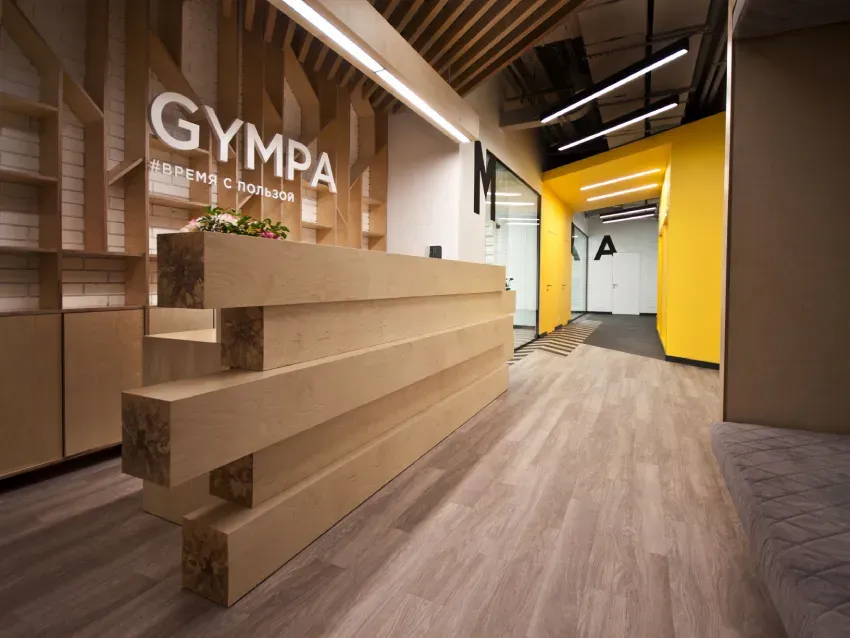When art becomes functional: the role of art objects in contemporary interior design.
Art objects in interior design aren't merely decorative elements tied to artworks. They can be functional items specially designed or selected for a particular space. Among their practical applications, art objects can be used for space zoning, ergonomic considerations, furniture functionality (like storage, seating, lying down, etc.), lighting enhancement, and improving a room's acoustic characteristics.
Art objects have become indispensable in modern interior design. They not only embellish spaces but also serve functional purposes. By 'art object,' we don't just mean traditional artwork, such as paintings or sculptures. For instance, large sculptures or installations can act as space dividers, segmenting vast rooms into multiple functional areas. Some installations even double up as unconventional furniture pieces like shelves or cabinets.

Custom-designed tree-shelf by KPD.design GYMPA
Moreover, art objects can enhance a room's acoustics, rendering sound gentler and more pleasant. They can also double as light sources, illuminating areas that need additional focus. Any strategically placed lamp can become an art object – a highlight in a room, the cherry on top. But the real advantage of art objects lies in their ability to be the centerpiece, drawing attention and creating an unparalleled ambiance in a room.
For art-object lighting solutions from Russian manufacturers, consider:
- LedMonster
- MDMlight
- Woodled
For ceramic table lamps, check out: - Ceramicatelier
- Sasha Kruglikova
- Ceramum

Bird-imitating lamps by MDMlight in a 3D interior Lobby of "Park Voyage" Hotel
Whether an art object is a sculpture, painting, or installation, it can be the key element in interior design, making a space unique and memorable. Additionally, art objects can be harnessed to craft themed interiors aligned with specific styles or epochs. In essence, integrating art objects into interiors is an excellent way to render a space both intriguing and functional, endowing it with a distinct character.
Here's a list of Russian manufacturers whose items can be considered art objects for your home:
- Eburet – 3D printed furniture items;
- Idea – whimsical furniture groups (cabinets, tables, nightstands, vanities) with prints on facades;
- Delo Design – minimalist furniture reminiscent of Gorky Park;
- Helen Loom – custom tapestries and woolen torchieres in nomad and wabi-sabi styles;
- Swog – home furniture and accessories;
- Odingeniy – uniquely crafted furniture pieces.

Eburet table and monkey-themed fresco on banana trees by Factura, KPD.design project Duplex in KP Varezhki-3
Here's the SEO-adapted and reader-friendly English translation:
This list showcases just a handful of Russian manufacturers we collaborate with in our projects when it comes to art installations. In designing residential or commercial spaces, we often incorporate custom finishes or bespoke furniture items. These pieces not only act as visual focal points but also serve a purpose, such as a table, shelving unit, wooden wall panels, or uniquely designed sofas and chairs. We are also creators, designing ceramic and furniture art pieces, crafted either by ceramic artists or by Russian furniture factories based on our sketches.
An art installation can take the form of special panels on walls or ceilings that enhance a room's acoustics, reducing noise levels. These installations can be crafted from various materials including fabric, wood, metal, and more, taking on diverse shapes, sizes, and colors to align with the room's design objectives.
This could include sound-absorbing panels that minimize sound reflection or porous materials that slow down sound wave transmission (ideal for spaces like recording studios, cinemas, conference rooms, and home theaters). Such installations can elevate acoustics in standard residential and commercial spaces, greatly enhancing comfort and ambient quality.
- Artfelt: Located in St. Petersburg, Artfelt produces felt panels in a range of sizes and colors.
- Greenboard: This eco-friendly company manufactures sound-absorbing panels for walls and ceilings using pine chips in cement, reminiscent of the ceilings in "Vkusno-i-tochka".
- Ekhokor: A producer based near Moscow, crafting panels from expanded polystyrene for walls and ceilings.
- Wool Design: Based in Sergiev Posad, Moscow Region, they produce environmentally-friendly felt panels for soundproofing.
- Flyfelt: This company, located near Moscow, produces felt panels suitable for both office and home settings.

Colorful "Ekhokor" panels in an office interior, designed by KPD.design
Modern interiors are evolving to be more functional and multifaceted, with art installations playing a pivotal role in establishing a unique and aesthetically appealing ambiance.
Here's the SEO-adapted and reader-friendly English translation:
A functional art installation typically refers to a unique piece of furniture or a custom wall or ceiling finish tailored by a designer for a specific interior. The term also encompasses artworks that serve purely aesthetic purposes to embellish a space. These art pieces can seamlessly fit various interior styles such as neoclassical, Scandinavian, minimalism, Japandi, nomad, loft, and many others. Rather than just accessorizing a room, these installations play a pivotal role in defining its essence, serving various functional purposes like space partitioning, soundproofing, or introducing light and color. Given their versatility and the diverse materials they can be crafted from, art installations can be integrated into any decor or style. They are more than just embellishments; they're key design elements that foster warmth and harmony in a space.

Reception desk and shelving by KPD.design for the interior of GYMPA
Among art installations, totems—inspired by ancient symbols commemorating specific events or individuals and often carrying deep symbolic meanings—are gaining popularity in modern interiors. Modern totems are decorative art pieces with diverse forms, whether carved from wood, assembled from ceramic tiles, or made from other materials. They can either take abstract shapes or represent animals, plants, and other entities.
Selecting art installations for an interior relies on multiple factors including design style, room size, special features, and the client's personal preferences.
Choosing the right art installations for an interior is a crucial step in room decoration. For art pieces like paintings or sculptures, the decision must factor in design style, room size, specific features, and client preferences. For instance, contemporary and abstract artworks are apt for minimalist spaces, while classical interiors may benefit from traditional paintings and sculptures. The scale of the art piece should complement the room's dimensions. Additionally, room lighting, color palette, and materials play a role in the selection. Ultimately, the right choices contribute to a harmonious and aesthetically pleasing interior that mirrors the owner's uniqueness and taste. We often recommend clients try out paintings and sculptures directly in their designed interiors to ensure the perfect fit.
The art fitting process allows potential buyers a temporary opportunity to experience an artwork in their own space, gauging how it complements their interior or simply to witness its live allure. This hands-on approach enables clients to make informed decisions, ensuring the piece fits harmoniously within their home or office. Usually, an artwork trial is set for a specified duration, during which a client can decide to purchase or return the piece. Most often, this process necessitates a contractual agreement and a security deposit.

Placement of the painting "The Sorrow of Loss" by a Peruvian artist from the client's collection, a KPD.design project at Duplex in KP Varezhki-3
We collaborate with various galleries and individual artists, assisting in tailoring the art to the interior. Art acquisitions can be viewed as profitable investments since certain artists' works appreciate over time. Alternatively, one might opt for pieces less about monetary value and more about capturing a mood, technique, or visual aesthetic that resonates personally.
We also partner with interior artists capable of creating mural artworks for your spaces, enriching them through collaborative efforts with our interior design team.
Art installations can be crafted from diverse materials such as metal, glass, wood, stone, etc., granting designers the liberty to opt for the best match for each unique interior.
Integrating art pieces in interior design helps craft distinctive and memorable spaces. The material choice for these installations plays a pivotal role. Every material boasts unique characteristics and aesthetics which can be harnessed to achieve specific impressions. For instance, metallic pieces can evoke a contemporary, industrial vibe, while wooden installations might infuse warmth and coziness. Additionally, material choice can impact cost and exclusivity, empowering designers to curate bespoke and individualistic designs for each client.
Carefully curated art installations can become the focal point of an interior, cultivating a unique ambiance that mirrors the owner's identity and accentuates the design ethos.
With art's dynamic power to tell stories, evoke emotions, and create atmospheres, its integration within interiors is paramount. Designers and homeowners alike understand this, thus constantly striving to find pieces that both complement and enhance spaces. These elements not only serve aesthetic purposes but also become conversational pieces, embodying the very essence of design's blend of form and function.
Art objects play a pivotal role in curating a cozy and stylish ambiance within interiors. Available in a diverse palette of forms, sizes, and hues, the right art object can metamorphose into a space's centerpiece. This could manifest as a wall tapestry, a rug, a painting, a unique sculpture, or even a ceramic vase. Such items are emblematic of fine arts. They underline the nuances of an interior's style, invariably crafting a specific mood. Additionally, they stand as testaments to the homeowner's identity and aesthetic inclinations.

A 3D bedroom interior featuring paintings by Leonid Malafeevsky, a KPD.design project at ZhK Life Kutuzovsky
Singular, bespoke interior design is unattainable without the incorporation and crafting of functional objects. This encompasses specialized lighting and custom-made furniture, conceptualized by the designer. These elements are integral for achieving a space that is not just stylish and cozy, but also profoundly evocative of the homeowner's unique personality.
In summation, it's incontrovertible that art objects are not mere decorative elements; they are distinctive artworks that complement interiors both aesthetically and functionally. This is deeply intertwined with the creation of a personalized interior design project. The selection of art objects must resonate with the design's style, the spatial attributes, and the client's personal tastes. Materials for art objects range from glass, concrete, wood, MDF, plastic, to polystyrene, granting designers a vast canvas to select the most fitting choice for every interior. Ultimately, a functionally devised interior design, accentuated by art, emphasizes the homeowners' style and distinctiveness, curating a matchless ambiance, be it in a private residence or a business setting.
With apt spatial zoning, harmonious volume-spatial composition, and the integration of art, the interior itself is transformed into a masterpiece!
To understand when you should engage a designer, delve into this ARTICLE.
For a consultation on your hotel's design, kindly fill out this FORM.


